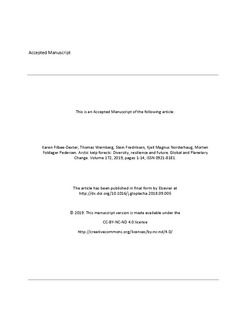| dc.contributor.author | Filbee-Dexter, Karen | |
| dc.contributor.author | Wernberg, Thomas | |
| dc.contributor.author | Fredriksen, Stein | |
| dc.contributor.author | Norderhaug, Kjell Magnus | |
| dc.contributor.author | Pedersen, Morten Foldager | |
| dc.date.accessioned | 2019-11-21T07:01:45Z | |
| dc.date.available | 2019-11-21T07:01:45Z | |
| dc.date.created | 2019-01-07T15:58:46Z | |
| dc.date.issued | 2019 | |
| dc.identifier.citation | Global and Planetary Change. 2019, 172, 1-14. | nb_NO |
| dc.identifier.issn | 0921-8181 | |
| dc.identifier.uri | http://hdl.handle.net/11250/2629606 | |
| dc.description | Embargo until 12 September 2020 | nb_NO |
| dc.description.abstract | The Arctic is one of the most rapidly changing places on Earth and it is a sentinel region for understanding the range and magnitude of planetary changes, and their impacts on ecosystems. However, our understanding of arctic coastal ecosystems remains limited, and the impacts of ongoing and future climate change on them are largely unexplored. Kelp forests are the dominant habitat along many rocky Arctic coastlines, providing structure and food for economically and ecologically important species. Here we synthesize existing information on the distribution and diversity of arctic kelp forests and assess how ongoing changes in environmental conditions could impact the extent, productivity, and resilience of these important ecosystems. We identify regions where the range and growth of arctic kelp are likely to undergo rapid short-term increase due to reduced sea ice cover, increased light, and warming. However, we also describe areas where kelps could be negatively impacted by rising freshwater input and coastal erosion due to receding sea ice and melting permafrost. In some regions, arctic kelp forests have undergone sudden regime shifts due to altered ecological interactions or changing environmental conditions. Key knowledge gaps for arctic kelp forests include measures of extent and diversity of kelp communities (especially northern Canada and northeastern Russia), the faunal communities supported by many of these habitats, and the role of arctic kelp forests in structuring nearby pelagic and benthic food webs. Filling in these gaps and strategically prioritizing research in areas of rapid environmental change will enable more effective management of these important habitats, and better predictions of future changes in the coastal ecosystems they support and the services that they provide. | nb_NO |
| dc.language.iso | eng | nb_NO |
| dc.publisher | Elsevier | nb_NO |
| dc.rights | Attribution-NonCommercial-NoDerivatives 4.0 Internasjonal | * |
| dc.rights.uri | http://creativecommons.org/licenses/by-nc-nd/4.0/deed.no | * |
| dc.title | Arctic kelp forests: Diversity, resilience and future | nb_NO |
| dc.type | Journal article | nb_NO |
| dc.type | Peer reviewed | nb_NO |
| dc.description.version | acceptedVersion | nb_NO |
| dc.source.pagenumber | 1-14 | nb_NO |
| dc.source.volume | 172 | nb_NO |
| dc.source.journal | Global and Planetary Change | nb_NO |
| dc.identifier.doi | 10.1016/j.gloplacha.2018.09.005 | |
| dc.identifier.cristin | 1651773 | |
| dc.relation.project | Norges forskningsråd: 255085 | nb_NO |
| cristin.unitcode | 7464,20,11,0 | |
| cristin.unitname | Marin biologi | |
| cristin.ispublished | true | |
| cristin.fulltext | original | |
| cristin.fulltext | postprint | |
| cristin.qualitycode | 1 | |

